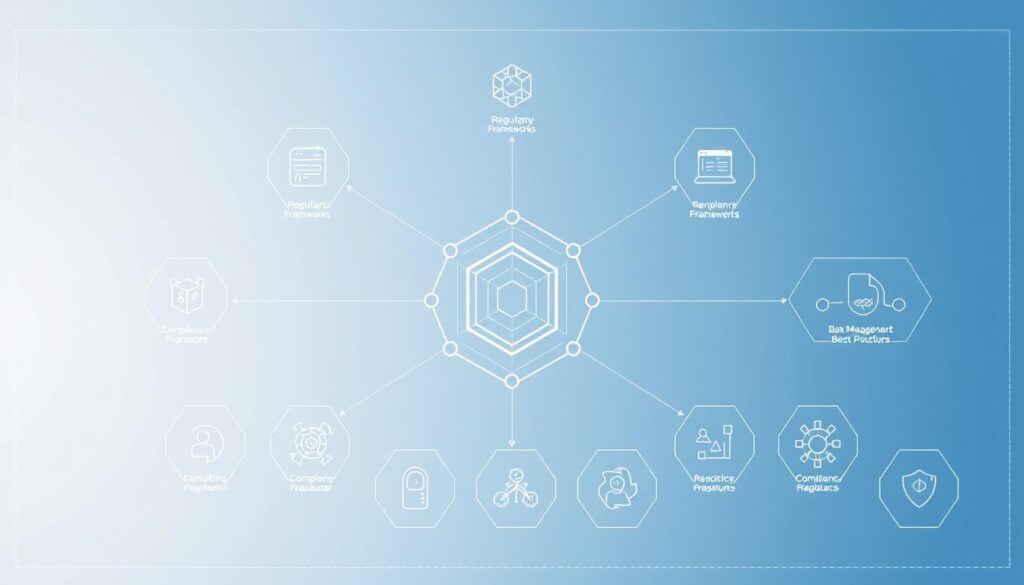Now Reading: Unlock the Power of Web3 Finance Solutions
- 01
Unlock the Power of Web3 Finance Solutions
Unlock the Power of Web3 Finance Solutions
The financial world is on the verge of a big change. This change comes from blockchain financial tools and new technologies. These advancements could make managing money much better.

Web3 finance solutions lead this change. They promise safer, clearer, and faster financial services. Thanks to blockchain, these solutions could change how we handle our money.
Key Takeaways
- Web3 finance solutions offer enhanced security and transparency.
- Blockchain technology is the backbone of these innovative solutions.
- Financial management is set to become more efficient and reliable.
- The potential for revolutionizing financial services is vast.
- Adoption of these solutions is expected to grow significantly.
The Web3 Financial Revolution
Web3 finance is more than just tech; it’s a new way to think about money. The old financial world is changing fast with decentralized finance technologies. People want services that are open, clear, and fair for everyone.
The Evolution from Traditional Finance to Web3
The move from old finance to Web3 is all about spreading power. Traditional banks are in the middle, controlling everything. Web3 uses blockchain technology for direct, open transactions. This change brings crypto banking services that let you handle money in a new way.
More people want decentralized finance technologies for better security, privacy, and control over money.
Key Principles of Decentralized Finance
DeFi stands out because of its core values. It’s all about decentralization, where money moves on a public ledger without one boss. It’s also about accessibility, letting anyone with the internet join in. And it’s all about transparency, with every deal open for all to see.
Smart contracts play a big role here. They make sure deals are done right and on time, making DeFi reliable and efficient.
The Fundamental Building Blocks of Web3 Finance
Web3 finance is built on a strong foundation. It uses blockchain technology and smart contracts for decentralized financial services. This setup makes transactions secure, transparent, and efficient. It’s changing traditional finance for the better.
Blockchain Technology as the Foundation
Blockchain is at the core of Web3 finance. It offers a secure and transparent ledger for all transactions. This decentralized ledger keeps transactions safe from tampering, building trust and cutting fraud risks.
Blockchain also helps create decentralized networks. These networks let transactions happen without middlemen. This makes transactions cheaper and faster. Plus, it opens the door to new financial products and services.
Smart Contracts: The Automated Enforcers
Smart contracts are key in Web3 finance. They act as automated enforcers of financial agreements. These self-running contracts ensure transactions are carried out as agreed, reliably and predictably.
Smart contracts lead to lower transaction costs and greater security. They also enable the creation of complex financial tools. As smart contract tech grows, so will its role in finance.
Exploring Web3 Finance Solutions for Businesses and Individuals
Web3 finance is changing how we deal with money. It’s thanks to decentralized finance (DeFi) and cryptocurrencies.
DeFi Protocols and Their Functions
DeFi protocols are making financial services better. They offer new ways to lend, borrow, and exchange assets. This is different from old financial systems.
Lending and Borrowing Protocols
Lending and borrowing protocols let users lend or borrow assets. Compound and Aave are big names in DeFi. They help users earn interest or get loans.
- Lending protocols help users earn interest on their assets.
- Borrowing protocols let users get loans by using their assets as collateral.
Decentralized Exchanges
Decentralized exchanges (DEXs) let users trade assets without middlemen. Uniswap and SushiSwap are well-known DEXs. They use blockchain for safe and clear trades.
- DEXs are places to trade digital assets.
- They cut out the need for middlemen, saving money.

The Role of Cryptocurrencies in Web3 Finance
Cryptocurrencies are key in Web3 finance. They are used for buying, storing value, and investing. Cryptocurrencies are very flexible, making DeFi work.
- Cryptocurrencies help with transactions in DeFi.
- They are a safe place to store value and can be used as collateral.
- Cryptocurrencies offer chances to make money through yield farming and liquidity mining.
Getting Started with Web3 Finance: Essential Tools and Resources
Exploring Web3 finance means knowing the key tools and resources. This decentralized world offers many chances for growth. But, you need the right tools and knowledge to succeed.
Setting Up Your Digital Wallet
A digital wallet is vital for Web3 finance. It lets you manage cryptocurrencies and use dApps. You must decide between a hardware or software wallet when setting one up.
Hardware vs. Software Wallets
Hardware wallets are physical and keep your keys safe offline. Ledger and Trezor are top choices. Software wallets, like MetaMask and Trust Wallet, are easy to use but less secure.
Multi-Signature Security Options
Multi-signature wallets need more approvals for transactions. This is great for those with big assets. It adds a strong security layer against unauthorized actions.
Selecting the Right Blockchain Networks
Choosing the right blockchain network is key. Different networks have different strengths. Look at Ethereum, Binance Smart Chain, and Polkadot. Consider fees, block times, and dApp ecosystems.
Security Essentials for Web3 Finance
Security is top priority in Web3 finance. Use secure wallets and pick reliable networks. Be cautious of phishing and smart contract risks. Always check websites and apps for safety.
With these tools and knowledge, you can confidently explore Web3 finance. It opens up new opportunities for growth and success.
Implementing Decentralized Banking Services
Decentralized banking is changing the financial world. It offers secure, clear, and fast banking options. These services use blockchain and cryptocurrencies to make finance more open and fair.
Creating and Managing Crypto Savings Accounts
Crypto savings accounts let you earn interest on your crypto. To start, pick a DeFi platform, deposit your crypto, and earn interest. It’s important to watch interest rates, know the platform’s rules, and be ready for market changes.
Crypto savings accounts offer high-interest rates and let you earn on many cryptos. But, it’s key to pick safe DeFi platforms to avoid risks.
Establishing Peer-to-Peer Transaction Systems
Peer-to-peer (P2P) systems are key in decentralized banking. They let users send money directly, without middlemen. To start, set up a digital wallet for your crypto and learn how to send money.
Setting Up Payment Channels
Setting up payment channels means picking a blockchain network. You need to make sure it can handle lots of transactions. You might also use layer 2 scaling solutions to boost speed.
Managing Transaction Fees
Keeping transaction fees low is important. Users should learn to optimize fees. This means choosing the right blockchain, setting the right fee rates, and using fee-saving tools.
Decentralized banking services offer enhanced security, lower costs, and more access to finance. As Web3 finance grows, decentralized banking can change the financial world a lot.
Leveraging Smart Contract Payment Systems
As we move towards a more decentralized financial system, smart contract payment systems are key. They make financial transactions more efficient and secure. By automating payments and cutting out middlemen, these systems make transactions smoother.
Automating Payment Processes with Smart Contracts
Smart contracts are self-running contracts with their rules written in code. They automate payments, making sure transactions happen as planned without needing middlemen.
Writing Basic Payment Smart Contracts
To create a basic payment smart contract, you need to outline the agreement’s terms. This includes who’s involved, how much is being paid, and when. You can use Web3 finance solutions to add smart contracts to your payment systems.
Testing and Deploying Your Contracts
After writing a smart contract, it’s important to test it. This means trying out different scenarios to make sure it works right. Once it passes the test, you can put it on a blockchain network.
Reducing Transaction Costs and Eliminating Intermediaries
Smart contract payment systems also cut down on transaction costs. They automate payments and get rid of middlemen. This makes financial transactions cheaper for businesses and individuals.
In summary, using smart contract payment systems boosts the efficiency and security of financial deals. They automate payments and lower costs, offering a better way to handle financial transactions.
Developing Cryptocurrency Investment Strategies
The cryptocurrency market is always changing. It’s key to have a solid investment plan to succeed. Investors face a world of digital assets, each with its own traits and growth potential.
Portfolio Diversification in the Crypto Space
It’s vital to diversify your crypto portfolio to manage risk. By investing in different types of assets, like Bitcoin, altcoins, and stablecoins, you can reduce losses. A good mix might include:
- Core holdings in established cryptocurrencies
- Investments in promising altcoins
- Stablecoins for hedging
Implementing Yield Farming and Liquidity Mining
Yield farming and liquidity mining can help you earn passive income. These methods involve adding liquidity to DeFi protocols for rewards.
Selecting Liquidity Pools
When picking liquidity pools, look at:
- Liquidity depth
- Trading volume
- Fee structures
Calculating Impermanent Loss
Impermanent loss happens when pool asset values change. It’s important to know how to calculate this to make smart choices.
Risk Management for Crypto Investments
Managing risk is crucial in the unpredictable crypto market. Good strategies include setting stop-loss orders, diversifying, and keeping up with market trends.
With a solid investment plan, you can handle the crypto market’s challenges. This way, you’re set for long-term success.
Mastering Blockchain-Based Borrowing and Lending
Understanding blockchain-based borrowing and lending is key in Web3 finance. It’s vital for both people and big organizations to know how to use these platforms well. This knowledge is growing more important as decentralized finance grows.
How to Use Decentralized Lending Platforms
Decentralized lending platforms are safe and clear ways to lend and borrow. To use them well, knowing the roles of lenders and borrowers is crucial.
Supplying Assets as a Lender
By lending assets on these platforms, you can earn interest. Here’s how it works:
- Deposit your assets into a smart contract
- Earn interest based on the platform’s rate
- Keep your assets liquid while earning
Borrowing Against Your Collateral
Borrowing against your assets lets you get money without selling. Important things to remember are:
- Make sure your assets’ value covers the loan
- Know the interest rates and repayment terms
- Keep your collateral ratio in check to avoid losing your assets
Optimizing Collateralization Ratios
Getting the most out of your collateral ratio is key for lenders and borrowers. A good ratio helps avoid risks and boosts earnings. Here are some tips:
- Watch market changes to adjust your collateral
- Keep a buffer to avoid losing your assets
- Spread out your collateral to lower risks
By learning about blockchain-based borrowing and lending, you can find new financial chances. This knowledge helps you move confidently in the changing Web3 world.
Digital Asset Management in the Web3 Era
In the fast-changing Web3 world, managing digital assets well is crucial. It opens up new financial opportunities. For both people and businesses, handling digital assets efficiently is getting more important.
Web3 finance brings new assets and ways to manage them. Digital asset management platforms lead this change. They offer advanced tools for managing different types of portfolios.

Incorporating NFTs as Financial Assets
NFTs, or Non-Fungible Tokens, are becoming key in digital asset management. They are unique digital items that can be traded like other goods. Adding NFTs to a portfolio can offer new ways to diversify and grow.
To use NFTs well, investors need to grasp their value. They should see how NFTs fit into their overall investment plan. This includes looking at their liquidity, demand, and where to trade them.
Implementing Tokenization of Real-World Assets
Tokenization turns real-world assets into digital tokens for blockchain trading. It makes assets more liquid, cuts costs, and reaches more investors.
By turning assets like real estate or art into tokens, investors get fractional ownership. This makes transfers easier. It’s important to pick the right blockchain and follow rules when tokenizing assets.
Building a Diversified Digital Asset Portfolio
A diverse digital asset portfolio is key for managing risk and boosting returns in Web3. It means spreading investments across various types, like cryptocurrencies, NFTs, and tokenized assets.
To diversify, consider your risk level, goals, and how different assets relate. Regularly rebalancing your portfolio helps keep it in the best shape.
Integrating Web3 Finance Solutions for Enterprise
Web3 finance solutions bring new chances for businesses. But, they need careful planning to work well. Companies must think about the tech and rules involved.
Connecting with Existing Financial Systems
For Web3 finance to work, it must link with current systems. This means steps like API integration and moving data.
API Integration Strategies
APIs are key for smooth talks between Web3 and old finance systems. Companies should pick strong APIs and use tools for upkeep.
- Select APIs that are safe and can grow
- Use tools to watch and fix APIs
- Make sure API guides are clear and easy to find
Data Migration Considerations
Moving data to Web3 systems is also vital. Companies need to plan this carefully to keep data safe and running smoothly. Important steps include:
- Check data quality and safety before moving
- Pick the best tools and ways to move data
- Test the data move well
Addressing Compliance and Regulatory Requirements
Companies using Web3 finance must follow many rules. They need to know the laws and make sure they follow them.
Key compliance considerations include:
- Know the rules for fighting money laundering and knowing customers
- Follow rules for financial reports and sharing info
- Use strong security to keep data safe
By focusing on these areas, companies can use Web3 finance well. This improves their money work and lowers risks.
Overcoming Challenges in Web3 Finance Adoption
Web3 finance solutions are becoming more popular, but there are still hurdles to cross. As the financial world changes, it’s important to tackle these challenges head-on. This will help make Web3 finance a success.
Addressing Scalability Issues
One big problem is scalability issues. Blockchain networks, the heart of Web3 finance, can’t handle as many transactions as traditional systems. To fix this, developers are working on new solutions.
They’re looking at sharding, off-chain transactions, and layer 2 scaling. These ideas aim to make blockchain networks faster and more efficient without losing their decentralized spirit.
Managing Volatility and Market Risks
Managing volatility is another big challenge. The crypto market is known for its ups and downs, which can shake the stability of Web3 financial products. To deal with this, people can spread out their investments, use hedging, and keep up with market news.
Also, creating more advanced financial tools, like derivatives and stablecoins, can help reduce risks.
Navigating the Evolving Regulatory Landscape
The regulatory landscape for Web3 finance is always changing. Different places have different rules for cryptocurrencies and DeFi. To get through this, businesses and individuals need to keep up with new laws and talk to lawmakers.
Following current rules and helping shape future ones is vital for Web3 finance to grow.
By tackling scalability issues, managing volatility, and navigating the regulatory landscape, we can speed up Web3 finance adoption. As the field gets better, solving these problems will be crucial to realizing Web3 finance’s full potential.
Case Studies: Successful Web3 Finance Implementations
Blockchain technology is changing financial services for the better. It boosts security, transparency, and efficiency in transactions. This shows the big potential of Web3 finance.

Small Business Use Cases
Small businesses are using Web3 finance to get better. For example, a Web3 innovation studio helped a small e-commerce site. They set up a new payment system that cut costs by 30% and sped up transactions.
- Improved payment processing times
- Reduced transaction fees
- Enhanced security through blockchain technology
Enterprise-Level Transformations
Big companies are also seeing big changes with Web3 finance. A top bank added Web3 rewards and NFT incentives to their loyalty program. This boosted customer engagement by 25%. More info on this is in studies on Web3 rewards and NFT incentives.
- Increased customer engagement through innovative loyalty programs
- Improved operational efficiency
- Enhanced brand reputation through the adoption of cutting-edge technology
Individual Investor Success Stories
Individual investors are also doing well with Web3 finance. They’re making good money by investing in digital assets and using decentralized lending platforms. Their stories show how Web3 finance can open up new financial opportunities for everyone.
The Future Landscape of Web3 Finance
The future of Web3 finance looks bright, with new trends set to change the financial world. Decentralized finance (DeFi) is growing, leading to more financial tools, better performance, and stronger security.
Web3 finance will soon blend with traditional finance, making it easier to work together. This mix could open up new chances for businesses and people, making finance more accessible and flexible.
Blockchain technology will keep playing a big role, with improvements in how it works and connects with others. As Web3 grows, we’ll see more advanced financial products and services. This will make decentralized finance even more powerful.
It’s important for everyone to keep up with the latest in Web3 finance. This way, they can take advantage of the exciting changes happening in this fast-evolving field.
FAQ
What are Web3 finance solutions, and how do they differ from traditional financial systems?
Web3 finance solutions use blockchain technology for financial services. They offer secure, transparent, and efficient services. This is different from traditional banking.
How do smart contracts work in Web3 finance?
Smart contracts are self-executing contracts with code terms. They automate financial processes. This reduces the need for intermediaries and speeds up transactions.
What is the role of cryptocurrencies in Web3 finance?
Cryptocurrencies are used for exchange, value storage, and investment in Web3 finance. They make transactions fast and secure. They also help with lending and diversifying investments.
How can I get started with Web3 finance, and what are the essential tools?
Start with a digital wallet and choose between hardware and software. Understand multi-signature security. Pick the right blockchain network and learn about security.
What are DeFi protocols, and how do they function?
DeFi protocols offer financial services like lending and trading on blockchain. They use smart contracts to automate these services. This provides a decentralized alternative to traditional finance.
How do I implement a cryptocurrency investment strategy?
Start by diversifying your portfolio. Understand yield farming and liquidity mining. Manage risk by selecting liquidity pools and calculating impermanent loss. Stay updated on market trends.
What are the benefits of using decentralized lending platforms?
Decentralized lending platforms let you lend and earn interest. You can also borrow against collateral. They offer a decentralized alternative, increasing accessibility and efficiency.
How can I manage the risks associated with Web3 finance?
Understand market volatility and regulatory changes. Implement risk management strategies. Stay informed, diversify, and use tools to minimize risks.
What is the future of Web3 finance, and what trends can we expect?
Web3 finance will evolve with increased adoption of DeFi. Blockchain technology will advance. Web3 solutions will integrate into traditional finance.















